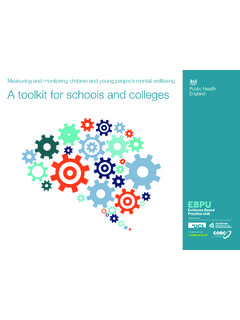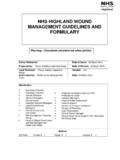Transcription of Code of Practice - qualityadvocacy.org.uk
1 A CODE OF Practice FOR ADVOCATES 1 Code of Practice Revised Edition 2014 A CODE OF Practice FOR ADVOCATES 2 Contents Page 1. Introduction .. 3 2. The Advocacy Charter .. 5 3. The Code of Practice .. 7 4. References .. 19 A CODE OF Practice FOR ADVOCATES 3 Introduction People are entitled to be in control of their own lives but sometimes, whether through disability, financial circumstances or social attitudes, they may find themselves in a position where their ability to exercise choice or represent their own interests is limited. In these circumstances, independent advocates can help ensure that an individual s rights are upheld and that views, wishes and needs are heard, respected and acted upon.
2 The Advocacy Charter The Advocacy Charter was published in July 2002 by Action for Advocacy and set out to define and promote key advocacy principles. The Charter provides advocacy schemes and others with a vehicle for both explaining what advocacy is and outlining a common vision of what constitutes effective advocacy. The Advocacy Charter principles and the Code of Practice have been revised in 2014, by Empowerment Matters CIC and the National Development Team for Inclusion (NDTi), to reflect changes in legislation as well as developments in advocacy Practice . What is the Code of Practice ? The Code of Practice is a set of guidelines for advocates and their managers, aimed at providing clarity, support and boundaries for their Practice .
3 It is also a guide for commissioners of advocacy services that outlines the expectations and purpose of the role and what clients as well as commissioners should expect from the delivery of the service. The Code provides a clear description of what is and is not expected of an advocate in their day-to-day work with clients. An effective Code of Practice can: Offer guidance to advocates in their role Inform clients of what they can realistically expect from their advocate/advocacy service Educate health, social care, third and private sector services, commissioners and others about the scope and limitations of the advocate s role Help to develop a better understanding of the training, supervision and support needs of advocates Raise awareness of the need for and benefits of independent advocacy for vulnerable people A CODE OF Practice FOR ADVOCATES 4 1 An individual might be able to express what they want, to go home, state what they like or dislike.
4 But may lack the capacity to instruct an advocate as to the action to take regarding a particular issue. Definition of advocacy Advocacy is taking action to help people say what they want, secure their rights, represent their interests and obtain services they need. Advocates and advocacy providers work in partnership with the people they support and take their side. Advocacy promotes social inclusion, equality and social justice. Definition of non-instructed advocacy Non-instructed advocacy takes place when a person lacks the capacity to instruct an The non-instructed advocate seeks to uphold the person s rights; ensure fair and equal treatment and access to services; and make certain that decisions are taken with due consideration for all relevant factors which must include the person s unique preferences and perspectives.
5 A CODE OF Practice FOR ADVOCATES 5 The Advocacy Charter Defining and promoting key advocacy principles CLARITY OF PURPOSE Clarity of purpose The advocacy provider s aims, objectives and planned activities are within the objects set out in its governing document and providers should be able to demonstrate how these meet the principles contained in this Charter. Advocacy providers should ensure that the people they advocate on behalf of, health and social care services and funding agencies have information on the scope and limitations of the advocacy provider s role. Independence The advocacy provider will be structurally independent from statutory organisations. The advocacy provider will be as free from conflict of interest as possible, both in design and operation of advocacy services, and seek actively to reduce conflicting interests, in particular where the organisation provides additional services such as housing provision.
6 Person Centred Approach The advocacy provider will ensure that the wishes and interests of the people it advocates on behalf of direct its work. Advocates should be non-judgmental and respectful of people s needs, views, culture and experiences. Empowerment The advocacy provider will support self-advocacy and empowerment through its work. People who access the service should have a say in the level of involvement and style of advocacy support they want where they are able and wish to. Where clients lack the ability or capacity to influence the service, the advocacy provider should have a process in place to enable those with an interest in the welfare of the person to influence this. Providers will ensure that people who want to, can influence and be involved in the wider activities of the organisation up to and including at Board level.
7 UAL OPPORTUNITY Equal Opportunity The organisation will have a written equal opportunities policy that recognises the need to be pro-active in tackling all forms of inequality, discrimination and social exclusion. The advocacy provider will have systems in place for the fair and equitable allocation of advocates time. Accessibility Advocacy will be provided free of charge to eligible people. Where clients need or want to purchase advocacy or where someone has an appointed deputy/attorney in place who wishes to instruct an advocate on the person s behalf, suitable processes should be in place to safeguard the person and ensure they are not open to financial abuse. The advocacy provider will aim to ensure that its premises (where A CODE OF Practice FOR ADVOCATES 6 appropriate), policies, procedures and publicity materials promote access for the population that it serves.
8 Supporting advocates The advocacy provider will ensure advocates are suitably prepared, trained and supported in their role and provided with opportunities to develop their knowledge, skills and experience. Accountability The advocacy provider will have systems in place for the effective monitoring and evaluation of its work, including identification of outcomes for people supported. All those who access the service will have a named advocate and a means of contacting them. Confidentiality The advocacy provider will have a written policy on confidentiality that is in line with the Data Protection Act 1998 and the Mental Capacity Act 2005. It should outline how information about a person accessing the service may be shared as well as the circumstances under which confidentiality might be breached.
9 Advocates must also be aware of situations that would require making a child or adult safeguarding alert. Complaints The advocacy provider will have a written policy describing how individuals, including relevant stakeholders, can make complaints or give feedback about the service or about individual advocates. Where necessary, the organisation will enable people who use its services to access external independent support to make or pursue a complaint. Safeguarding Clear policies and procedures will be in place to ensure safeguarding issues are identified and acted upon. Advocates will be supported to understand the different forms of abuse and neglect, issues relating to confidentiality and what to do if they suspect a client is at risk.
10 A CODE OF Practice FOR ADVOCATES 7 Code of Practice Clarity of purpose 1. Advocates should be clear about the nature and extent of their role. They should understand the boundaries of their own advocacy role and non-advocacy roles such as mediation and advice giving. 2. Advocates should not act outside of these boundaries. Advocates should seek permission (where the client has the capacity to consent or refuse) to refer people on to other agencies where appropriate. 3. Advocates should refer clients who lack capacity to consent to other appropriate services, including other advocacy providers, where appropriate/in their best interests (in accordance with the Mental Capacity Act 2005). 4. Advocates should be able to explain, in straightforward language, what advocacy is and isn t; why some people need advocacy; where people have a statutory right to access advocacy; where there is a statutory duty placed on the NHS or Local Authority to instruct an advocate; and the benefits advocacy can bring.





